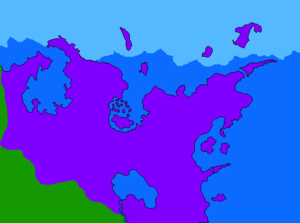Purple hare: Difference between revisions
No edit summary |
No edit summary |
||
| Line 9: | Line 9: | ||
|habitat = | |habitat = | ||
|discovery = {{AN|1173}} | |discovery = {{AN|1173}} | ||
|locale = {{team flag|Lac Glacei}}, {{team flag|Hurmu}}, {{team flag| | |locale = {{team flag|Lac Glacei}}, {{team flag|Hurmu}}, {{team flag|Meckelnburgh}} | ||
|related = None | |related = None | ||
|danger = Least Concern | |danger = Least Concern | ||
Revision as of 18:44, 11 December 2024
Scientific Name: Sylvilagus purpurea  |
|
Physical Description Body Type: Rodentia Biological Information Diet: Herbivorous |
The Purple hare, also called the Apollonian purple hare, is a species of rabbit native to the northeastern quarter of Apollonia. It is unique purple and white fur, owing to a genetic mutation brought on by high levels of ionizing radon released millennia ago (which also created the extensive amethyst deposits found in the Purple Isles and Eesdeheito). In the very early days of Micras the animal was worshipped and led to the establishment of the Purple Bunny Federation along the western shores of the Violette Sea. The animal's presence is much more rare in the southern and western regions of Apollonia and was, in fact, considered an evil omen by the ancient citizens of Blackrock - so much so that Blackrock and the PBF became mortal enemies. Even today, some ethnic Blackrockians living in Jingdao still consider the purple hare a portent of bad tidings. Around the rest of the globe however they are very popular as pets and easily domesticated. It is popular, though no longer worshipped, in the Purple Isles, the successor to the PBF.
Their natural range has extended to include much of the northeast, especially where they have colonized islands that, without any natural predators, their populations have exploded. The spread of urbanization and decrease in predators has led to a drastic spread of their original population center along the coast of the Violette Sea to now encompass much of northeastern Apollonia. Their popularity as pets and frequent release into the wild has intensified spreading the population even further.
